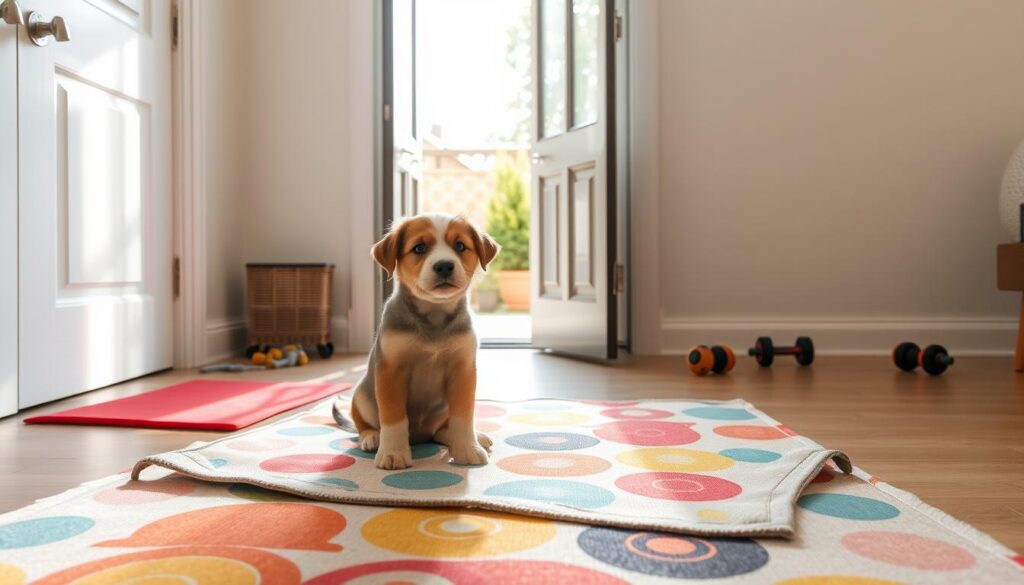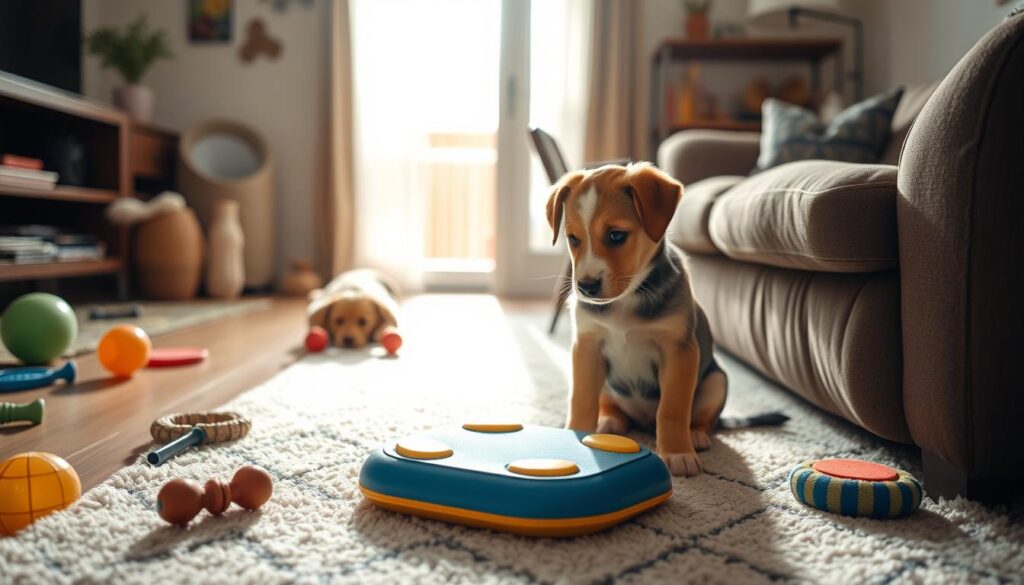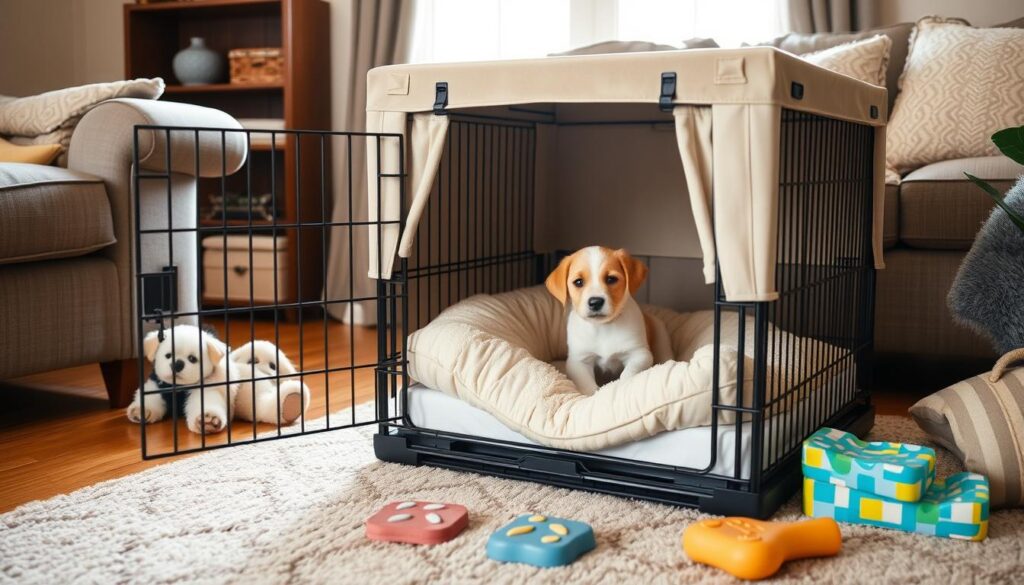Physical Address
304 North Cardinal St.
Dorchester Center, MA 02124
Physical Address
304 North Cardinal St.
Dorchester Center, MA 02124

Is your furry friend constantly leaving unexpected surprises around the house? House training your dog can be tough, but it’s doable with the right steps. You can turn your pup into a well-behaved, housebroken friend. Learn the secrets to successful puppy potty training and how to use positive reinforcement to house-train your dog.

House training a puppy is key to a happy home. It usually takes 4-6 months to a year to fully train a puppy. Puppies sleep a lot, up to 18 hours a day, and learn to control their bladder and bowels as they grow.
Puppies can hold their bladder for about an hour for each month of age, up to 9-12 months. It’s important to have a regular schedule for feeding, potty breaks, and crate time. Dogs often prefer the crate for naps and see it as their own space.
Puppies should never have free access to the house unless someone is watching. They need to go out in the morning, after meals, and after exercise. Positive reinforcement helps puppies learn good habits during house training.
Be ready for accidents and clean them up well to avoid dogs returning to the same spots. Every puppy is different, so adjust your training to fit their needs. Being patient and consistent is crucial for successful house training. This way, dogs learn to go outside to relieve themselves quickly.
House training your puppy or dog needs the right tools. First, get a crate that fits your dog well, a strong leash, and tasty treats for rewards. You might also need indoor dog potty pads or a bathroom for inside use.
Make sure your dog’s crate is cozy. Add toys and blankets to make it a comfy den. Also, have enzymatic cleaners ready to remove smells and prevent accidents in the same place. Keep small, easy-to-digest treats handy to reward your dog for good behavior.
| Essential House Training Supplies | Purpose |
|---|---|
| Appropriately Sized Crate | Creates a comfortable, den-like space for your dog |
| Leash | Allows you to closely monitor and guide your dog’s behavior |
| Treats | Provides positive reinforcement for desired potty behaviors |
| Enzymatic Cleaner | Effectively removes odors and deters repeat accidents |
| Puppy Pee Pads or Indoor Dog Potty | Offers an alternative bathroom option in specific situations |
With these key supplies, you’re ready to start house training your dog. It’s a big step towards a successful journey together.
Creating a consistent potty training schedule is key for house-training your dog. It’s important to adjust the schedule based on your puppy’s age and habits. Puppies under 8 weeks need to go out every 45 minutes. Those over 12 weeks can hold it for about 2 hours during the day.
Begin by taking your puppy out in the morning, before bed, and after meals and play. This routine helps your puppy learn when and where to go. As your puppy grows, you can increase the time between potty breaks.
| Puppy Age | Potty Break Frequency |
|---|---|
| Under 8 weeks | Every 45 minutes |
| 8-12 weeks | Every 1-2 hours |
| Over 12 weeks | Every 2 hours |
Keep a log of your puppy’s feeding times and successful potty breaks. This helps you spot patterns and adjust the schedule. It also helps you know when your pup needs to go, reducing accidents. Remember, being consistent and positive is crucial for a successful dog potty schedule and puppy house-training tips.
House-training a puppy can seem tough, but it’s doable with the right steps. Use the “House Training Triangle” method to create a routine. This method combines crate time, outdoor breaks, and supervised house time.
Begin with equal crate and free time. As your puppy gets better, add more free time and less crate time. Always watch your dog during free time to catch any accidents. Take them outside right away if they show signs like sniffing or whining.
Encourage good behavior with a consistent command like “go potty.” Praise them a lot when they go outside. Clean up accidents well to remove scents and avoid punishment. This helps your puppy feel safe and learn faster.
| House Training Tips | Recommended Frequency |
|---|---|
| Take your puppy outside | Every 1-2 hours for puppies under 12 weeks |
| Provide consistent feeding schedules | To avoid accidents indoors |
| Use positive reinforcement | Reward with praise, treats, or toys after successful outdoor elimination |
| Avoid punishment | As it can create fear and resentment in your puppy |
Stick to the “House Training Triangle” and these tips for a successful potty training. It will make both you and your dog happy and well-trained.

Crate training is a great way to house train puppies and dogs. It uses a dog’s instinct to not soil their sleeping area. This makes crates a key part of potty training.
First, pick a crate that fits your dog well. It should let them stand, turn, and lie down easily. For growing puppies, use a divider to make the space bigger as they grow. Make the crate welcoming by adding treats and toys inside.
Start with short crate times and slowly increase it. Never punish your dog in the crate. This can make them hate it. When it’s time to leave, take them straight to their potty spot.
How long crate training takes varies. It depends on your dog’s age, personality, and past experiences. Puppies under 6 months should not be in the crate for more than 3-4 hours. With patience and positive rewards, crate training puppies and dog obedience training can lead to good house training.

Crate training is often seen as the best way to potty train dogs. It helps create a positive crate association. This can also make the crate a safe, cozy spot for your dog in different situations. With the right method, crate training is a valuable tool in dog obedience training.
Positive reinforcement is key for house-training your puppy. Reward your pup right after they go outside. Use high-value treats and lots of praise to show they did well.
Don’t scold them for accidents. It can make them anxious and slow down training. Instead, quickly take them outside when they make a mistake.
Being consistent is important. Make sure everyone uses the same commands and rewards. This helps your puppy understand what’s expected.
Every small success is worth celebrating. It keeps the training fun for both you and your puppy. Dogs like simple commands like “sit,” “stay,” and “come.”
Positive reinforcement should only reward good behavior. Avoid rewarding bad behavior by accident. Shaping behavior means teaching your dog to do more before you reward them.
Use treats, praise, or toys to reward your puppy. Food treats work well because dogs love food. Start by rewarding every time, then less often once they learn.
Don’t let treats turn into table food. This can make your puppy beg. Positive reinforcement builds a strong bond between you and your puppy. It helps with house-training and makes your relationship better.
Accidents can happen during house training, but you can manage them well. If your puppy has an accident, act fast. Catch them in the act and take them outside to their toilet area right away.
Cleaning up is key to prevent more accidents. Use enzymatic cleaners to remove pet odors. These products break down urine compounds, removing the scent that might attract your dog. Don’t use ammonia-based cleaners, as they can smell like urine to your puppy.
Never punish your dog for accidents. This can harm the training and your bond. Instead, watch them more closely and check your training schedule if accidents keep happening. Keep cleaning supplies ready for quick clean-ups.
| Statistic | Value |
|---|---|
| Healthy adult dogs should be able to control their bladder and bowels for | 8 hours |
| Dogs that have a habit of eliminating on grass or dirt would rather not eliminate on | concrete or gravel |
| Consistent diet of high-quality premium brand dry food is | recommended |
| Crate training is one of the most efficient and effective ways to | train a dog |
| Dogs do not like to soil their resting/sleeping quarters if given adequate opportunity to eliminate | elsewhere |
Having a regular feeding schedule is key for house training your dog. Puppies do best with 2-3 meals a day. This helps them go to the bathroom at the same times every day.
Choose high-quality puppy food that your dog likes. Watching how your dog’s stool looks and changing their diet if needed is important. It helps a lot with house training.
To cut down on nighttime bathroom trips, take away your dog’s water 2.5 hours before bed. Feed your dog at the same times as their potty breaks. This makes their training easier.
Feed your dog in their crate about 10 minutes before you take them outside. This helps them go to the bathroom right away.
Being consistent is very important for dog potty schedule and puppy house-training tips. A regular feeding schedule and watching what your dog eats helps a lot. It makes house training easier and cuts down on accidents.
Even the most diligent dog owners may face challenges during house training. But, with patience and the right approach, these issues can be solved. First, check for any medical problems with a vet visit. For small breeds, indoor potty options like puppy pads or litter boxes can be helpful.
If your dog keeps soiling the same spot, clean the area well and limit access. Don’t give your dog too much freedom too soon to avoid accidents. If your dog soils the crate, check if the crate is the right size and give more breaks. Dogs from confined backgrounds may need extra time and support.
If problems persist, get help from a certified dog trainer or behaviorist. Consistent positive reinforcement and patience are crucial. They will help your dog become a well-trained, house-friendly family member.